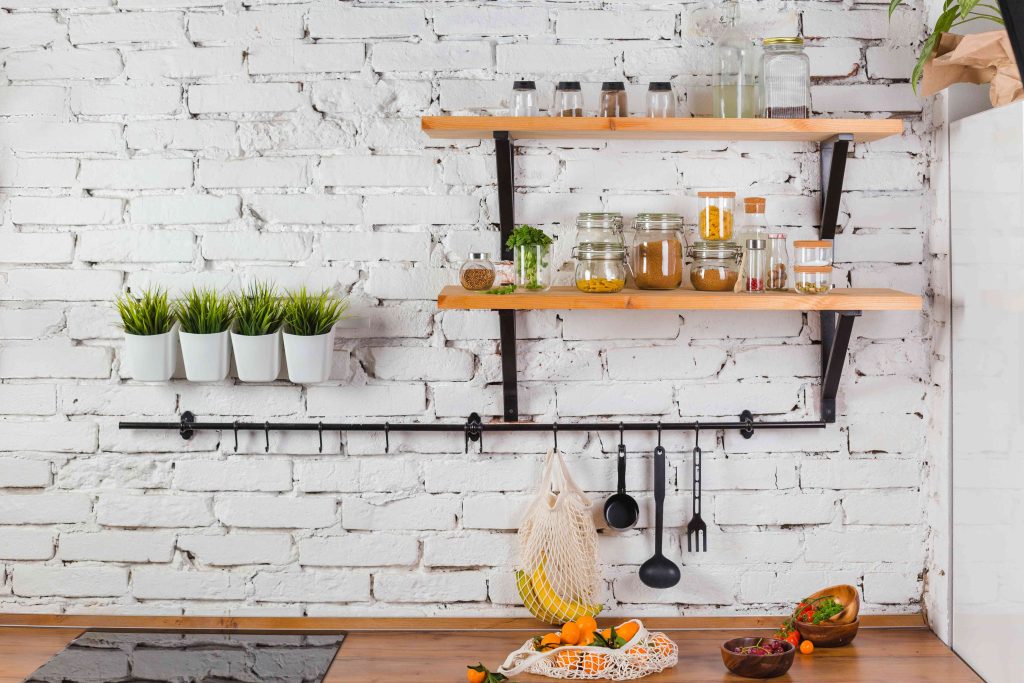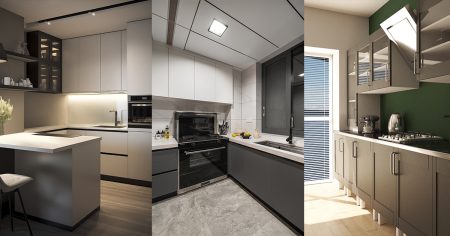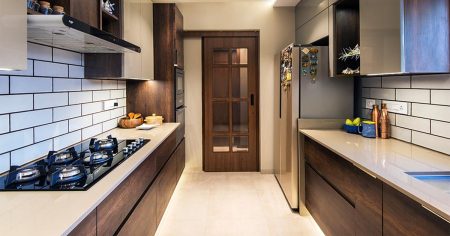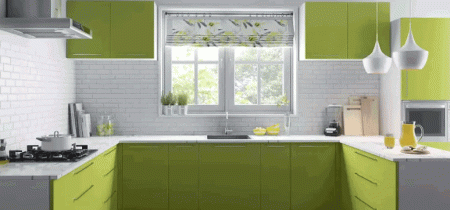A brick backsplash in the kitchen is unique and eye-catching. It makes a good backsplash, and it’s easy to install when using veneer options. It is also easy to clean using handwashing dish soap as long as it has been coated with a polyurethane sealant. Meanwhile, a brick backsplash grabs your attention and conveys an air of timeless permanence. It’s a welcome departure from ceramic, glass, or stone tile or countertop material extensions.
Read on for the instructions on how to build a brick backsplash using veneer brick. Also, learn more about using faux brick panels and why building a backsplash with real bricks is not recommended.
What Is a Brick Backsplash?
A brick backsplash is a hard covering for the wall behind the kitchen countertops. It is decorative and functional. As decor, a brick backsplash creates a solid, classic look. Functionally, a brick backsplash protects the wall from damage with its hard, thick covering.
A new brick backsplash is usually made from a molded brick-like veneer masonry unit, not extruded brick. In older homes, a brick backsplash in the kitchen made up of solid brick may be original to the home, not an added feature.
Types of Materials to Use
| Veneer Bricks | Faux Brick Veneer Panels | |
| Material | Masonry | High-density polyurethane |
| Face Size | 2 to 2 1/4 inches high by 8 inches long | 27 inches high by 48 inches long |
| Thickness | 1/4 inch | 5/8 to 3/4 inch |
| Cost | $7 to $10 per square foot | $10 to $15 per square foot ($80 to $120 per panel) |
| Fire Tolerance | Fireproof | Fire-rated but not fireproof or heatproof |
| Cleaning | Soap and water | Soap and water |
| Water | Water-resistant after sealing | Waterproof |
Veneer Brick
-
Fireproof (can be used behind stoves)
-
Impact resistant
-
Looks like genuine brick
-
Hard and solid
-
Must be sealed
-
Difficult to clean
-
Susceptible to chipping
-
Requires mortar and grout
The best material for creating a brick backsplash is veneer or face brick, a type of manufactured stone that comes in various colors and styles: whitewashed, red, gray, multi-colored, weathered, smooth, and more. Veneer brick is attractive, cost-effective, thin, and fireproof.
Veneer brick looks like authentic brick because it is a masonry product, but it is not true brick. It’s only decoration and not structural. It is thin brick, light, and can adhere to the backsplash wall (including drywall) without needing lower support. It is applied with thin-set mortar (the same material used for tile) or with glue. Grout applied to the joints between the bricks is purely decorative.
This manufactured veneer stone is made in molds and cured like concrete, not fired like a brick. It is comprised of Portland cement, aggregates, and iron oxides. Since it is not a through-body unit, the coloration lies on the surface. Extruded through-body thin bricks can be difficult for homeowners to find.
What Is Through-Body?
Through-body means that the color and material extend through it. Through-body brick or tile wears well since chips only reveal more of the same material below.
Faux Brick Veneer Panels
-
Lightweight
-
Simple to install with glue
-
Easy to clean
-
Waterproof; no need to seal
-
Easier to damage than brick veneer
-
May not look authentic
-
Not fireproof
-
Available only in large panels
Veneer brick panels are a brick backsplash alternative, sometimes called faux veneer or faux brick. These large-format panels are polystyrene and contain the impressions of many bricks (around 45 to 55) on a single panel. This brick alternative is perfect for do-it-yourselfers who want to quickly install a brick-looking backsplash without dealing with mortar or grout.
As a polymer, veneer brick panels offer the advantage of being waterproof, no sealing needed. They’re so lightweight that they attach to the wall with construction glue or come in peel-and-stick sheets. Unfortunately, veneer panels can be easily crushed or chipped upon impact. They are rated to ASTM E84 Class-A fire standards but are not fireproof. This rating only ensures that the panel has specific surface-burning characteristics.
Real Bricks
Full-size clay or concrete brick (used for building walls or creating pathways) is generally not an option for kitchen backsplashes. Full-size brick may be cheap, but it is not practical for backsplashes due to its size and weight.
A full-size brick generally measures 4 inches by 8 inches by 2 inches thick. A full-size brick would eat up 4 inches of a 25-inch kitchen counter’s limited depth. Also, the bricks would need to rest on the counter; their weight (about 5 pounds per square foot) would be too much for the counter to handle.
What You’ll Need
Equipment / Tools
- Cordless drill with bits and drivers
- Manual screwdriver
- Wet tile saw, rail tile cutter, or hacksaw
- Grout bag
- Brick jointer
- Square-notch trowel
- Shop vacuum
- Tape measure
- Clean rags
- Plastic sheeting
- Tape
- Paint brush
Materials
- 18 square feet of brick veneer
- Thinset mortar
- Grout
- 80-grit sandpaper
- Electrical box extenders
- Concrete sealer
- Caulk and caulking gun
Instructions
How to Install a Brick Veneer Backsplash
-
Measure Backsplash Area
Measure the length of the countertop and the desired height of the backsplash. Multiply the numbers, then add 10 percent to account for wastage. So, an 8-foot run of countertop would require around 18 square feet of brick veneer for a 24-inch backsplash.
-
Cover Countertops
Cover the countertops with plastic sheeting. Tape the plastic in place.
-
Remove Faceplates
At the electric service panel, flip off the circuit breaker to turn off the electricity to the wall area. Remove faceplates from light switches and outlets with the cordless drill or manual screwdriver.
-
Prepare Substrate
If the drywall is in good condition, it can be lightly sanded by hand with 80-grit sandpaper to scuff it up. This will help the thin-set mortar stick better. Clean the wall with the shop vacuum and a dry, clean rag.
-
Apply Thinset Mortar
Use the flat side of the trowel to pick up and spread thin-set mortar on the wall. Then switch to the square-notch side and comb the surface to leave lines of thin-set about 1/8-inch high.
-
Press Brick Veneer in Place
Begin at the countertop and work upward. Leave a 1/8-inch gap between the bottom of the brick and the counter to allow for movement. Press the brick into the wet thin-set by gently wiggling it back and forth. Hold it until it sticks, then move on to the next one. Leave a joint of about 1/4-inch or as desired between the bricks.
-
Cut Brick Veneer
As you reach an obstruction or outlet, cut the brick. Use a wet tile saw to cut the brick. You can also cut brick veneer on a rail tile cutter or hacksaw.
-
Finish Brick at Top
When you reach the bottom of the wall cabinets or the ceiling, decide whether to cut bricks lengthwise or leave a gap. Generally, if the gap is greater than half the height of the brick, cut filler bricks. If it is less than half, you can usually leave a hole, which will not be highly noticeable.
-
Add Grout
Mix up the grout and fill the grout bag. Twist off the end. Squeeze grout into the joints. Smooth the grout with the jointing tool.
-
Add Caulk
With the caulking gun, add caulk to the gap between the bottom of the brick and the countertop.
-
Seal Surface
After the grout is fully cured, brush on transparent concrete sealer. Apply two to three coats until the brick surface is fully sealed.
-
Add Electrical Box Extenders and Plates
Add extenders to the electrical boxes. Then reinstall the outlets and light switches. Finish by reinstalling the faceplates.
Durability
As a hard surface, a brick veneer backsplash wears better than painted drywall. However, a brick backsplash made of molded veneer bricks can be less durable than other types of hard surfaces since chips or scratches remove the top color and reveal the gray cement-like body. Most manufacturers have touch-up paint for this purpose. Extruded thin bricks will not have this problem.
Size and Spacing
A brick backsplash can extend from the top of the kitchen countertop to as high as the ceiling. Or depending on location, it may stop at the bottom of the wall cabinets.
Brick veneer is sized to have the exact side dimensions as actual brick: around 2 inches high by 8 inches long. This type of brick veneer comes in single units the size of one brick.
Since wall cabinets tend to rise anywhere from 18 to 24 inches above countertop height, faux brick panels are perfectly sized for that gap: usually 26 to 27 inches high. Two faux brick panels could cover an 8-foot stretch of countertop backsplash.
Brick veneer or panels increase the thickness of the wall by 1/4 to 3/4 inches, so electrical boxes need to be extended outward.
Brick Backsplash Cost
A brick backsplash will cost about $250 to $350 for 16 square feet. Brick veneer comprises most of that cost: about $150 to $200 for 18 to 20 square feet.
Another $100 to $150 will cover the thin-set mortar, grout, and specialty tools you may not already have.
Faux brick veneer panels cost about 25 to 30 percent more than brick veneer. But the extra cost might be recouped because few other materials or tools must be purchased.
Maintenance and Cleaning
One of the downsides of using brick for a backsplash is that it can be challenging to clean if it is not sealed. Brick is porous and can potentially soak up food spills, so it must be coated. The joints between the bricks also make cleaning brick a challenge. The joints must also be sealed.
Sealing the Brick and Mortar
Several layers of clear (often polyurethane) water-based sealer are applied to the entire surface of the brick backsplash. If the painted brick is your desired look, the paint will act as the sealer for the brick.
-
Can you put brick veneer on drywall?
You can install brick veneer on any flat surface, like drywall.
-
How do you clean fake brick backsplash?
Wash a faux brick backsplash using handwashing dish soap and water. Scrub with a soft-bristled brush. Wipe away with water and a clean towel to eliminate streaks. Do not use chemical cleaners or all-purpose sprays.
-
How do you keep moisture out of bricks?
Brick is susceptible to dampness. To keep moisture out of bricks, use a high-quality sealant. A sealant protects the bricks from moisture, efflorescence, color fading, crumbling, mold and mildew.
-
How long does brick sealer last?
Depending on the brand of brick sealant and how well it was applied, a sealant can last three to 15 years before needing reapplication. The average lifespan of sealant is about seven years.
Read the full article here














